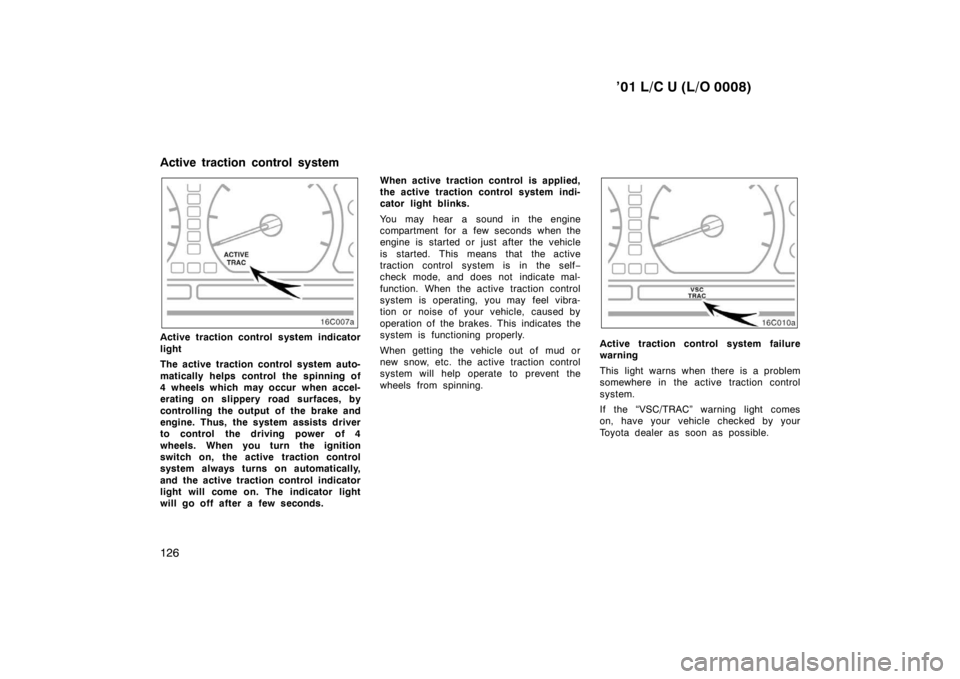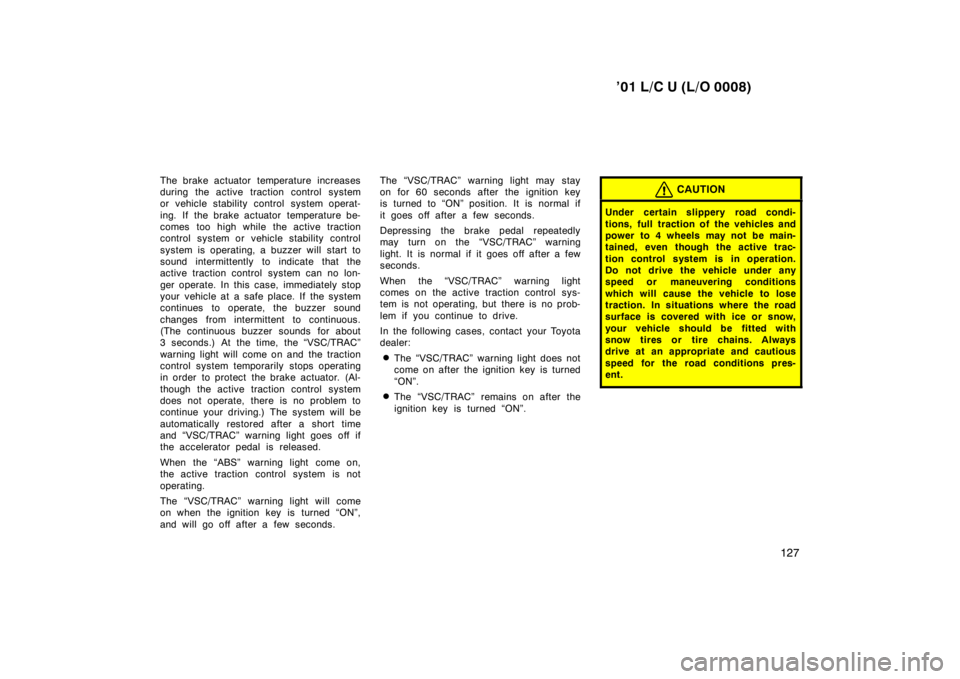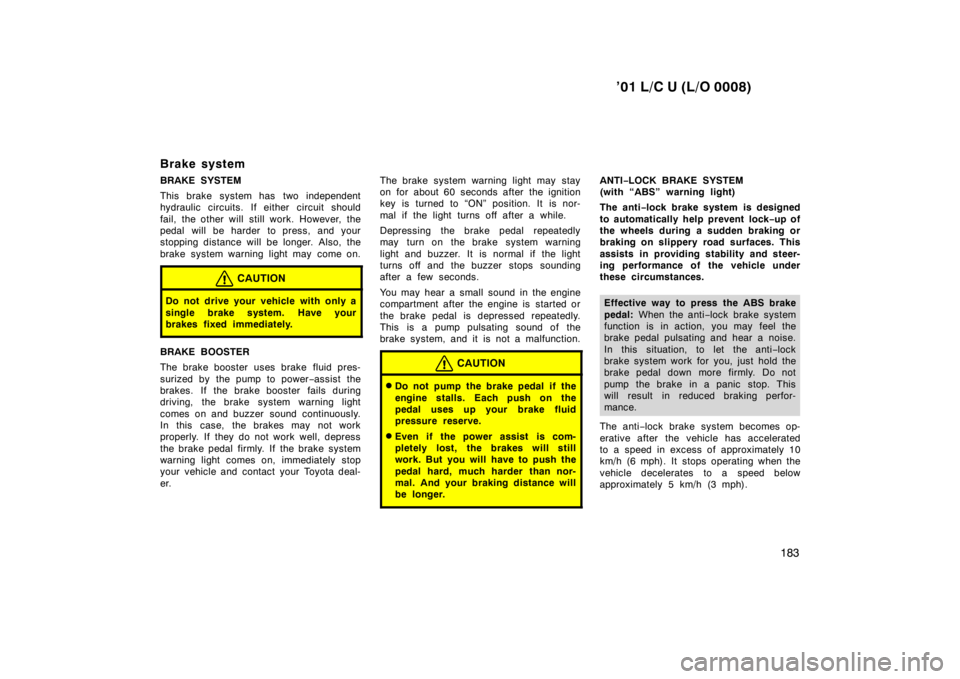2001 TOYOTA LAND CRUISER wheel
[x] Cancel search: wheelPage 46 of 142

’01 L/C U (L/O 0008)
126
Active traction control system indicator
light
The active traction control system auto-
matically helps control the spinning of
4 wheels which may occur when accel-
erating on slippery road surfaces, by
controlling the output of the brake and
engine. Thus, the system assists driver
to control the driving power of 4
wheels. When you turn the ignition
switch on, the active traction control
system always turns on automatically,
and the active traction control indicator
light will come on. The indicator light
will go off after a few seconds. When active traction control is applied,
the active traction control system indi-
cator light blinks.
You may hear a sound in the engine
compartment for a few seconds when the
engine is started or just after the vehicle
is started. This means that the active
traction control system is in the self
−
check mode, and does not indicate mal-
function. When the active traction control
system is operating, you may feel vibra-
tion or noise of your vehicle, caused by
operation of the brakes. This indicates the
system is functioning properly.
When getting the vehicle out of mud or
new snow, etc. the active traction control
system will help operate to prevent the
wheels from spinning.Active traction control system failure
warning
This light warns when there is a problem
somewhere in the active traction control
system.
If the “VSC/TRAC” warning light comes
on, have your vehicle checked by your
Toyota dealer as soon as possible.
Active traction control system
Page 47 of 142

’01 L/C U (L/O 0008)127
The brake actuator temperature increases
during the active traction control system
or vehicle stability control system operat-
ing. If the brake actuator temperature be-
comes too high while the active traction
control system or vehicle stability control
system is operating, a buzzer will start to
sound intermittently to indicate that the
active traction control system can no lon-
ger operate. In this case, immediately stop
your vehicle at a safe place. If the system
continues to operate, the buzzer sound
changes from intermittent to continuous.
(The continuous buzzer sounds for about
3 seconds.) At the time, the “VSC/TRAC”
warning light will come on and the traction
control system temporarily stops operating
in order to protect the brake actuator. (Al-
though the active traction control system
does not operate, there is no problem to
continue your driving.) The system will be
automatically restored after a short time
and “VSC/TRAC” warning light goes off if
the accelerator pedal is released.
When the “ABS” warning light come on,
the active traction control system is not
operating.
The “VSC/TRAC” warning light will come
on when the ignition key is turned “ON”,
and will go off after a few seconds.
The “VSC/TRAC” warning light may stay
on for 60 seconds after the ignition key
is turned to “ON” position. It is normal if
it goes off after a few seconds.
Depressing the brake pedal repeatedly
may turn on the “VSC/TRAC” warning
light. It is normal if it goes off after a few
seconds.
When the “VSC/TRAC” warning light
comes on the active traction control sys-
tem is not operating, but there is no prob-
lem if you continue to drive.
In the following cases, contact your Toyota
dealer:
� The “VSC/TRAC” warning light does not
come on after the ignition key is turned
“ON”.
� The “VSC/TRAC” remains on after the
ignition key is turned “ON”.
CAUTION
Under certain slippery road condi-
tions, full traction of the vehicles and
power to 4 wheels may not be main-
tained, even though the active trac-
tion control system is in operation.
Do not drive the vehicle under any
speed or maneuvering conditions
which will cause the vehicle to lose
traction. In situations where the road
surface is covered with ice or snow,
your vehicle should be fitted with
snow tires or tire chains. Always
drive at an appropriate and cautious
speed for the road conditions pres-
ent.
Page 48 of 142

’01 L/C U (L/O 0008)
128
The vehicle skid control system helps
provide comprehensive control of sys-
tems such as anti −lock brake, traction
control, engine control, etc. This sys-
tem automatically controls the output of
the brakes or engine to help prevent
the vehicle from skidding under adverse
conditions.
When you turn the ignition switch on, the
slip indicator light will come on. The slip
indicator light will go off after a few sec-
onds. If the vehicle is going to skid during driv-
ing, the slip indicator light flashes and an
alarm sounds intermittently.
The vehicle skid control system activates
when the vehicle speed is more than the
following speed. Four
−wheel drive control lever in “H”
15 km/h (9 mph)
. . . . . . . . . . . . . . . . . . . . . . . Four −wheel drive control lever in “L”
30 km/h (19 mph)
. . . . . . . . . . . . . . . . . . . . . . .
You may hear a sound in the engine
compartment for a few seconds when the
engine is started or just after the vehicle
is started. This means that the vehicle
skid control is in the self −check mode and
does not indicate a malfunction.Pushing the center differential lock button
automatically turns the vehicle skid control
system off. At this time, the “VSC OFF”
indicator comes on with the center differ-
ential lock indicator light. (For details, see
“Four −wheel drive system—(a)Four −wheel
drive control” in this section.)
Vehicle skid control system
Page 49 of 142

’01 L/C U (L/O 0008)129
Vehicle skid control system failure
warning
These lights warn when there is a prob-
lem somewhere in the vehicle skid control
system or active traction control system.
If the “VSC/TRAC” warning light and “VSC
OFF” indicator light come on, have your
vehicle checked by your Toyota dealer as
soon as possible. However, there is no
problem the “VSC/TRAC” warning light
comes on when the brake actuator tem-
perature becomes high. (For details, see
“Active traction control system” in this
section.) When the “ABS” warning light comes on,
the vehicle skid control system is not op-
erating.
The “VSC/TRAC” warning light and “VSC
OFF” indicator light will come on when the
ignition key is turned “ON”, and will go off
after a few seconds.
The “VSC/TRAC” warning light and “VSC
OFF” indicator light may stay on for 60
seconds after the ignition key is turned to
“ON” position. It is normal if they go off
after a few seconds.
Depressing the brake pedal repeatedly
may turn on the lights. It is normal if they
go off after a few seconds.
When the “VSC/TRAC” warning light and
“VSC OFF” indicator light come on, the
vehicle skid control system is not operat-
ing, but there is no problem if you contin-
ue to drive.
In the following cases, contact your Toyota
dealer:
� The “VSC/TRAC” warning light, “VSC
OFF” indicator light and slip indicator
light do not come on after the ignition
key is turned “ON”.
� The “VSC/TRAC” warning light and
“VSC OFF” indicator light remain on af-
ter the ignition key is turned “ON”.
� The “VSC OFF” indicator light comes
on while driving without pushing the
center differential lock switch.
CAUTION
�Active traction control system, ve-
hicle skid control system and anti −
lock brake system are electronic
systems designed to help the driver
maintain control under adverse con-
ditions. They are not a substitute
for safe driving practices. Factors
including speed, road conditions
and driver steering input can all af-
fect whether active traction control
system, vehicle skid control system
and anti −lock brake system will be
effective in preventing a loss of
control. Always keep safety driving
in mind. If the slip indicator light
flashes, sounding an alarm, special
care should be taken while driving.
� Only use tires of specified size. The
size, manufacturer, brand and tread
pattern for all 4 tires should be the
same. If you use the tires other
than specified, or different type or
size, the vehicle skid control sys-
tem may not function correctly.
When replacing the tires or wheels,
contact your Toyota dealer. (See
“Checking and replacing tires” in
Section 7 −2.)
Page 91 of 142

’01 L/C U (L/O 0008)183
Brake system
BRAKE SYSTEM
This brake system has two independent
hydraulic circuits. If either circuit should
fail, the other will still work. However, the
pedal will be harder to press, and your
stopping distance will be longer. Also, the
brake system warning light may come on.
CAUTION
Do not drive your vehicle with only a
single brake system. Have your
brakes fixed immediately.
BRAKE BOOSTER
The brake booster uses brake fluid pres-
surized by the pump to power
−assist the
brakes. If the brake booster fails during
driving, the brake system warning light
comes on and buzzer sound continuously.
In this case, the brakes may not work
properly. If they do not work well, depress
the brake pedal firmly. If the brake system
warning light comes on, immediately stop
your vehicle and contact your Toyota deal-
er. The brake system warning light may stay
on for about 60 seconds after the ignition
key is turned to “ON” position. It is nor-
mal if the light turns off after a while.
Depressing the brake pedal repeatedly
may turn on the brake system warning
light and buzzer. It is normal if the light
turns off and the buzzer stops sounding
after a few seconds.
You may hear a small sound in the engine
compartment after the engine is started or
the brake pedal is depressed repeatedly.
This is a pump pulsating sound of the
brake system, and it is not a malfunction.
CAUTION
�
Do not pump the brake pedal if the
engine stalls. Each push on the
pedal uses up your brake fluid
pressure reserve.
� Even if the power assist is com-
pletely lost, the brakes will still
work. But you will have to push the
pedal hard, much harder than nor-
mal. And your braking distance will
be longer.
ANTI −LOCK BRAKE SYSTEM
(with “ABS” warning light)
The anti −lock brake system is designed
to automatically help prevent lock −up of
the wheels during a sudden braking or
braking on slippery road surfaces. This
assists in providing stab ility and steer-
ing performance of the vehicle under
these circumstances.
Effective way to press the ABS brake
pedal: When the anti −lock brake system
function is in action, you may feel the
brake pedal pulsating and hear a noise.
In this situation, to let the anti −lock
brake system work for you, just hold the
brake pedal down more firmly. Do not
pump the brake in a panic stop. This
will result in reduced braking perfor-
mance.
The anti −lock brake system becomes op-
erative after the vehicle has accelerated
to a speed in excess of approximately 10
km/h (6 mph). It stops operating when the
vehicle decelerates to a speed below
approximately 5 km/h (3 mph).
Page 92 of 142

’01 L/C U (L/O 0008)
184
Depressing the brake pedal on slippery
road surfaces such as on the manhole
cover, the steel plate under the construc-
tion, joints in the bridge, etc. on a rainy
day tends to activate the anti
−lock brake
system.
You may hear a click or motor sound in
the engine compartment for a few seconds
when the engine is started or just after
the vehicle is started. This means that the
anti −lock brake system is in the self
check mode, and does not indicate a mal-
function.
When the anti −lock brake system is ac-
tivated, the following conditions may
occur. They do not indicate a malfunc-
tion of the system:
� You may hear the anti −lock brake sys-
tem operating and feel the brake pedal
pulsating and the vibrations of the body
and steering wheel. You may also hear
the motor sound in the engine compart-
ment even after the vehicle is stopped.
� At the end of the anti −lock brake sys-
tem activation, the brake pedal may
move a little forward.
CAUTION
Do not overestimate the anti −lock
brake system: Although the anti −lock
brake system assists in providing ve-
hicle control, it is still important to
drive with all due care and maintain
a moderate speed and safe distance
from the vehicle in front of you, be-
cause there are limits to the vehicle
stability and effectiveness of steering
wheel operation even with the anti −
lock brake system on.
If tires grip performance exceeds its
capability, or if hydroplaning occurs
during high speed driving in the rain,
the anti −lock brake system does not
provide vehicle control.
Anti −lock brake system is not de-
signed to shorten the stopping dis-
tance: Always drive at the moderate
speed and maintain a safe distance
from the vehicle in front of you.
Compared with vehicles without an
anti −lock brake system, your vehicle
may require a longer stopping dis-
tance in the following cases: � Driving on rough, gravel or snow −
covered roads.
� Driving with tire chains installed.
� Driving over the steps such as the
joints on the road.
� Driving on roads where the road
surface is pitted or has other differ-
ences in surface height.
Install all 4 tires of specified size at
appropriate pressure: The anti −lock
brake system detects vehicle speeds
using the speed sensors for respec-
tive wheels’ turning speeds. The use
of tires other than specified may fail
to detect the accurate turning speed,
resulting in a longer stopping dis-
tance.
Page 93 of 142

’01 L/C U (L/O 0008)185
“ABS” warning light
The light comes on when the ignition
key is turned to the “ON” position. If
the anti−lock brake system and the
brake assist system work properly, the
light turns off after a few seconds.
Thereafter, if either of the systems mal-
functions, the light comes on. When the “ABS” warning light is on (and
the brake system warning light is off), the
anti
−lock brake system, the brake assist
system, the vehicle skid control system
and/or active traction control system do/
does not operate, but the brake system
still operates conventionally.
When the “ABS” warning light is on (and
the brake system warning light is off), the
anti −lock brake system does not operate
so that the wheels could lock up during
a sudden braking or braking on slippery
road surfaces.
If either of the following conditions oc-
curs, this indicates a malfunction some-
where in the parts monitored by the
warning light system. Contact your
Toyota dealer as soon as possible to
service the vehicle.
� The light does not come on when the
ignition key is turned to the “ON” posi-
tion, or remains on.
� The light comes on while you are driv-
ing.
A warning light turning on briefly during
operation does not indicate a problem.
CAUTION
If the “ABS” warning light remains on
together with the brake system warn-
ing light, immediately stop your ve-
hicle at a safe place and contact your
Toyota dealer.
In this case, not only the anti −lock
brake system will fail but also the
vehicle will become extremely unsta-
ble during braking.
Either of the following conditions may
occur, but do not indicate the malfunc-
tion.
� The light may stay on for about 60
seconds after the ignition key is turned
to “ON” position. It is normal if it turns
off after a while.
� Depressing the brake pedal repeatedly
may turn on the light. It is normal if it
turns off after a few seconds.
Page 96 of 142

’01 L/C U (L/O 0008)
188
Rear step bumper
The rear step bumper is for rear end
protection and easier step
−up loading.
To get on the rear step bumper, use the
shaded area between the arrows in the
illustration.
CAUTION
� Do not allow more than one per-
son to get on the rear step bum-
per at a time. It is designed for
only one person.
� Never drive the vehicle with any-
one on the rear step bumper.
Limited −slip differential
Some Toyotas are equipped with a lim-
ited −slip differential. If one of the rear
wheels begins to spin, the limited −slip dif-
ferential is designed to aid traction by
automatically transmitting driving force to
the other rear wheel. If you are not sure
whether your vehicle is equipped with one,
you can ask your Toyota dealer.
CAUTION
Do not start or run the engine while
your vehicle is supported by a jack.
The vehicle could be driven off the
jack and could pose a danger or re-
sult in serious injury.
NOTICE
Use only a spare tire of the same
size, construction and load capacity
as the original tires on your Toyota
because damage to the limited −slip
differential could possibly occur with
another tire type.
The vehicle identification number (VIN)
is the legal identifier for your vehicle.
This number is on the left top of the
instrument panel, and can be seen
through the windshield from outside.
This is the primary identification number
for your Toyota. It is used in registering
the ownership of your vehicle.
Your Toyota’s identification—
—Vehicle identification
number